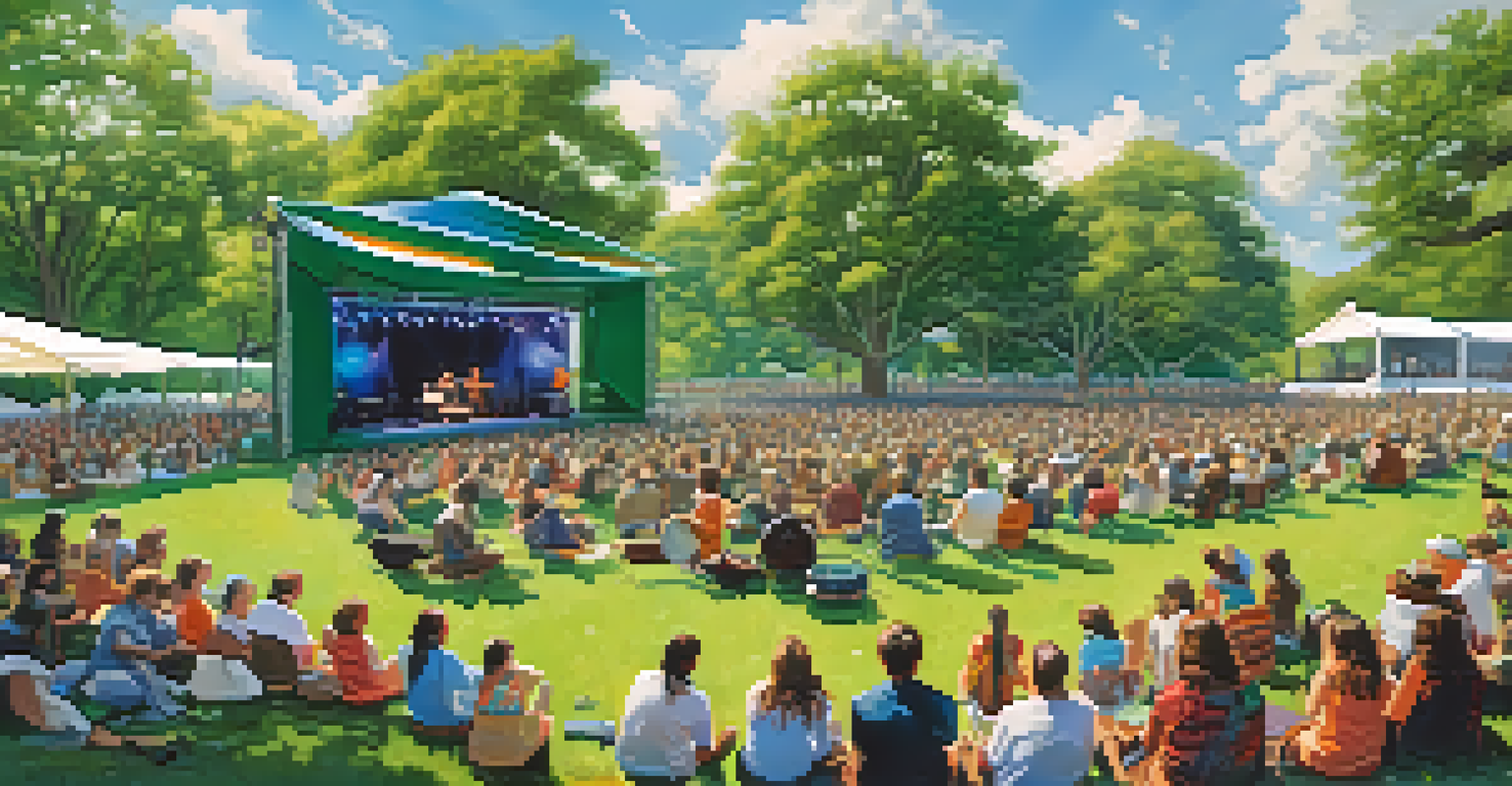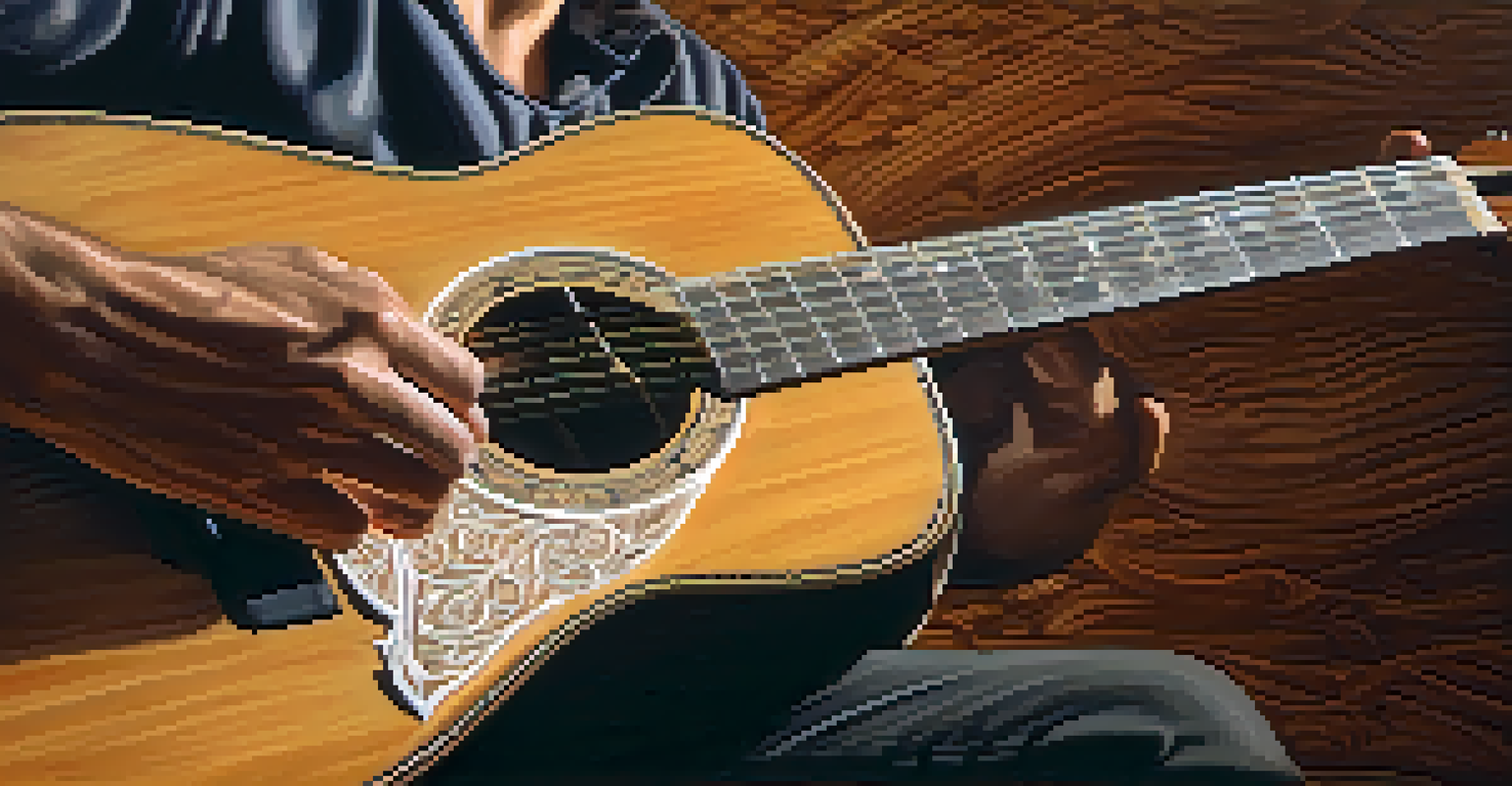The Evolution of Guitar in Folk Music Across Different Cultures

The Origins of the Guitar and Its Early Influence
The guitar's journey begins with ancient stringed instruments like the lute and oud, which paved the way for its development. These early instruments, popular in various regions, set the stage for what would become the modern guitar. The transition from these early forms to the guitar we know today showcases how culture and music intertwine.
The guitar is a miniature orchestra in itself.
As these instruments spread across Europe, they adapted to local traditions, influencing folk music styles. For example, the Spanish guitarra evolved into a key instrument in Flamenco music, rich with passion and rhythm. This adaptability highlights how the guitar has been embraced across cultures, becoming a staple in folk traditions.
By the 19th century, the guitar had firmly established its place in many folk music scenes, from the rural Appalachian sound to the vibrant sounds of Latin America. The instrument became a vehicle for storytelling, allowing musicians to connect with their audiences emotionally. This connection continues to resonate today, making the guitar an enduring symbol of folk music.
Cultural Variations: The Guitar in Latin American Folk Music
In Latin America, the guitar plays a central role in various folk music styles, such as samba, bossa nova, and mariachi. Each genre showcases the guitar's versatility, whether in the rhythmic strumming of samba or the intricate melodies of bossa nova. This diversity illustrates how the guitar has been adapted to fit different cultural narratives.

For instance, in Mexico, the guitarrón and the standard guitar often work together to create a rich sound in mariachi bands. This collaboration emphasizes how traditional folk instruments can evolve while maintaining cultural significance. The guitar's ability to blend with other instruments showcases its role in creating a unique musical tapestry.
Guitar's Cultural Significance
The guitar has evolved across cultures, serving as a key instrument in various folk traditions and embodying the rich narratives of different communities.
Moreover, the storytelling aspect of Latin American folk music is often conveyed through the guitar, making it an essential tool for cultural expression. Songs about love, loss, and social issues resonate deeply with audiences, reinforcing the guitar's importance in these communities. As a result, the guitar not only entertains but also serves as a means of preserving cultural heritage.
The Guitar's Role in American Folk Music Heritage
The American folk music scene is heavily influenced by the guitar, particularly during the early 20th century. Artists like Woody Guthrie and Pete Seeger utilized the instrument to bring attention to social issues and connect with working-class communities. The guitar became a symbol of protest and hope, resonating deeply with the American spirit.
Music can change the world because it can change people.
The folk revival of the 1960s further solidified the guitar's presence in American music, with artists like Bob Dylan blending traditional sounds with contemporary themes. This period marked a significant transformation, where the guitar not only provided melody but also served as a powerful voice for change. The instrument became an essential part of cultural movements, embodying the sentiments of the times.
Today, the guitar continues to thrive in American folk music, with new generations of artists drawing inspiration from their predecessors. Acoustic festivals and open mic nights celebrate this rich heritage, ensuring that the guitar remains a vital part of the folk music landscape. The instrument's evolution reflects the ongoing story of American culture and its diverse musical influences.
Guitar Innovations: The Electric Influence in Folk Music
With the advent of electric guitars in the mid-20th century, folk music began to embrace new sounds and styles. Artists like Joan Baez and Neil Young incorporated electric guitars, blending traditional folk with rock influences. This shift opened up a world of possibilities, allowing musicians to experiment with different genres and sounds.
The electric guitar brought a new energy to folk music, leading to the creation of sub-genres like folk-rock. The fusion of acoustic roots with electric instrumentation created captivating performances that drew in larger audiences. This evolution showcased the guitar's adaptability and its ability to transcend traditional boundaries.
Guitar as a Voice for Change
Throughout history, musicians have utilized the guitar to address social issues, making it a powerful tool for activism and a symbol of hope.
Today, the electric guitar continues to play a significant role in folk music, with artists using effects and amplifiers to create unique sounds. This innovation reflects the ongoing evolution of the guitar, proving that it can adapt while remaining true to its folk origins. The blend of electric and acoustic elements keeps the genre fresh and exciting for new listeners.
Global Perspectives: The Guitar Across Cultures
While the guitar is often associated with Western music, it has found its way into folk traditions worldwide. In Africa, for example, the ngoni and the kora serve as traditional stringed instruments that have influenced modern guitar styles. This cross-cultural exchange highlights the guitar's ability to bridge gaps between different musical heritage.
In Asia, the guitar has been embraced in various forms, from the Japanese shamisen to the Indian sitar. These instruments share similarities with the guitar, showcasing the universal appeal of stringed instruments. This cultural integration emphasizes the guitar's role as a global instrument, adaptable to various musical expressions.
As musicians continue to collaborate across cultures, the guitar's influence expands, resulting in exciting fusions of folk traditions. This evolution not only enriches the music but also fosters a greater appreciation for diverse cultures. The guitar's journey across the globe is a testament to its enduring legacy and versatility.
The Guitar as a Tool for Social Change in Folk Music
Throughout history, the guitar has served as a powerful tool for social change in folk music. Artists have used their music to address issues like inequality, war, and environmental concerns, making the guitar a voice for the voiceless. This aspect of folk music illustrates the instrument's ability to connect deeply with audiences and inspire action.
In many cultures, folk musicians have taken to the streets with their guitars, using song to rally communities for social justice. This practice highlights how music can be a catalyst for change, uniting people under a common cause. The guitar becomes more than just an instrument; it transforms into a symbol of hope and resilience.
Future Innovations in Folk Music
As technology and social media evolve, the guitar's adaptability ensures its continued relevance in the changing landscape of folk music.
The legacy of the guitar in social movements continues today, with musicians using their platforms to raise awareness and advocate for change. The power of a simple chord progression can resonate far beyond the stage, sparking conversations and encouraging activism. This enduring impact reinforces the guitar's role as a vital instrument in the ongoing fight for justice.
The Future of the Guitar in Folk Music
As technology advances, the future of the guitar in folk music looks promising. Digital platforms have allowed musicians to reach audiences worldwide, sharing their unique interpretations of folk traditions. This accessibility ensures that the guitar remains a relevant instrument in the evolving landscape of music.
Moreover, the rise of social media has fostered a new generation of guitarists who blend traditional styles with contemporary sounds. This fusion of genres keeps folk music fresh and exciting, attracting diverse audiences. The guitar's adaptability continues to ensure its relevance in a constantly changing music scene.

Looking ahead, the guitar will likely continue to evolve, embracing new technologies and influences while honoring its rich history. As artists push boundaries and explore new sounds, the guitar will remain an integral part of folk music, connecting generations through shared stories and experiences. The future holds endless possibilities for this beloved instrument.